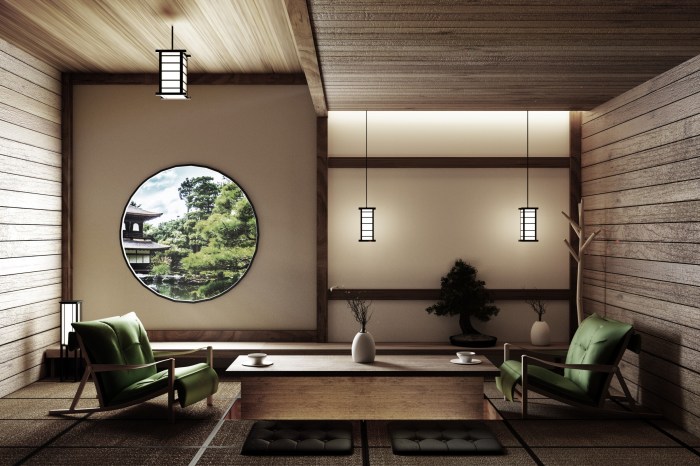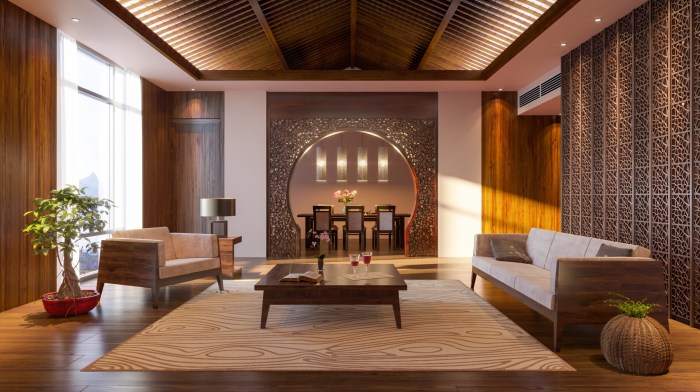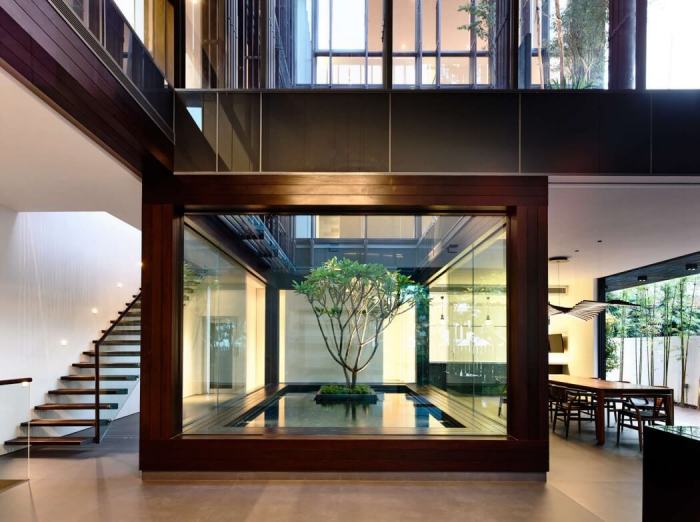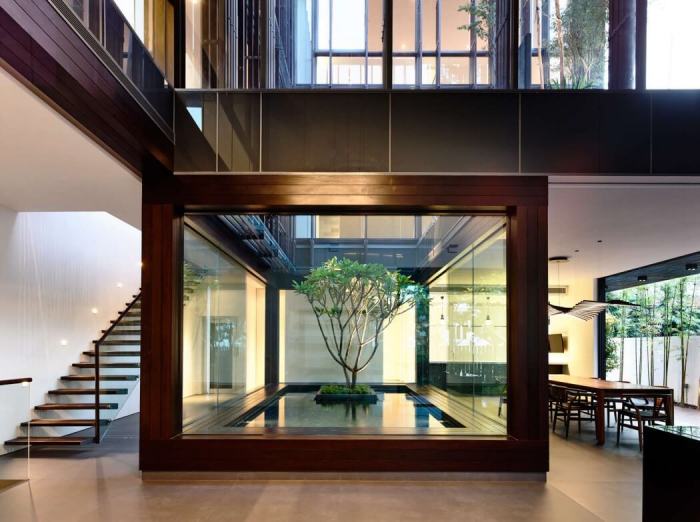Asian house interior design is a captivating blend of tradition and modernity, reflecting the rich cultural heritage of the continent. From the serene principles of Feng Shui to the vibrant use of color and intricate details, Asian homes offer a unique and inviting aesthetic.
This journey explores the diverse influences, design elements, and contemporary interpretations that shape the distinctive character of Asian interiors.
The article delves into the cultural influences that shape Asian interior design, examining how traditional design principles like Feng Shui are incorporated into modern homes. It explores the significance of color symbolism in different Asian cultures and how color is used to create specific moods and atmospheres.
The article also discusses the use of natural materials, traditional furniture, and lighting techniques that contribute to the distinctive ambiance of Asian interiors.
Regional Variations

Across Asia, interior design styles showcase a fascinating tapestry of cultural influences, climate adaptations, and historical legacies. From the minimalist elegance of Japan to the vibrant colors of India, each region boasts a unique aesthetic that reflects its distinctive identity.
Climate and Culture Influence
Climate and cultural practices significantly impact interior design choices in Asian countries. For instance, in hot and humid climates, such as Southeast Asia, homes often feature open floor plans with ample ventilation and natural light. This design strategy promotes air circulation and keeps interiors cool.
Asian house interior design often incorporates elements like natural materials, minimalist aesthetics, and a focus on functionality. However, even in smaller spaces, these principles can be applied. For instance, a 200 sq ft house interior design can utilize clever storage solutions and light colors to create an illusion of spaciousness, while still incorporating traditional Asian motifs like bamboo accents or paper lanterns.
In contrast, colder regions like Northern China and Korea prioritize insulation and warmth, often incorporating traditional heating systems and thicker materials.
Asian house interior design often incorporates elements of nature, like bamboo and wood, creating a sense of tranquility and harmony. To fully visualize these concepts, you can explore the 3d view of house interior design option, which allows you to experience the design in a virtual environment.
This can help you understand how different materials and textures interact, ultimately guiding you towards creating a truly unique and inviting Asian-inspired space.
Examples of Regional Design Elements
- Japan:Minimalist aesthetics, natural materials like wood and bamboo, tatami flooring, shoji screens, and traditional tea rooms.
- China:Rich colors, intricate carvings, silk fabrics, traditional furniture like the kang bed, and decorative elements like calligraphy and paintings.
- India:Vibrant colors, intricate patterns, traditional textiles like silk and cotton, carved wood furniture, and religious motifs.
- Thailand:Open floor plans, natural materials like teak wood, ornate carvings, traditional temples, and vibrant textiles.
- Vietnam:Traditional architecture featuring red brick walls, wooden beams, and tiled roofs, with interior design often incorporating traditional lacquerware, silk fabrics, and religious iconography.
Creating an Asian-Inspired Interior

Creating an Asian-inspired interior is a beautiful way to bring a sense of tranquility and sophistication into your home. The key is to incorporate elements that reflect the rich cultural heritage of Asia, while also considering your personal style and preferences.
Asian house interior design often emphasizes natural elements, incorporating wood, bamboo, and stone to create a sense of tranquility. When designing a smaller space like a 2BHK, maximizing functionality and creating a harmonious flow becomes crucial. You can find inspiration for such projects on websites like 2bhk house interior design where you can explore different layout ideas and color palettes.
By incorporating traditional Asian design principles into a 2BHK, you can achieve a stylish and functional space that reflects your personal style.
Designing a Living Room Layout
To create a harmonious and inviting living room, consider incorporating the following elements:
- Open Floor Plan:Asian design often emphasizes open spaces and a seamless flow between areas. This can be achieved by minimizing walls and using furniture to define different zones within the room.
- Natural Light:Maximize natural light by using large windows and skylights. This creates a bright and airy atmosphere, which is essential for a tranquil living space.
- Focal Point:Choose a focal point for the room, such as a beautiful artwork, a traditional screen, or a fireplace. This draws the eye and creates a sense of balance.
- Low Furniture:Low-lying furniture, such as sofas and coffee tables, is a hallmark of Asian design. It creates a sense of intimacy and invites relaxation.
- Minimalist Decor:Avoid clutter and stick to a few carefully chosen pieces. This creates a sense of calm and serenity.
Mood Board for an Asian-Inspired Bedroom, Asian house interior design
A mood board can help visualize the overall aesthetic of an Asian-inspired bedroom. Here are some key elements to include:
- Color Palette:Choose a calming and harmonious color palette, such as shades of white, beige, gray, and soft blues. You can add pops of color with accents of red, gold, or jade green.
- Materials:Incorporate natural materials such as wood, bamboo, silk, and stone. These materials bring a sense of warmth and authenticity.
- Furniture:Select furniture with clean lines and simple designs. Consider using a low platform bed, a traditional chest, or a writing desk with a delicate screen.
- Accessories:Add finishing touches with accessories such as silk cushions, ceramic vases, or lanterns. These details can add a touch of elegance and cultural significance.
Asian Design Elements
| Element | Cultural Significance | Modern Applications |
|---|---|---|
| Bamboo | Symbol of strength, flexibility, and longevity in many Asian cultures. | Used in furniture, flooring, wall coverings, and decorative accents. |
| Silk | Represents luxury, beauty, and refinement in Chinese culture. | Used in fabrics, curtains, wall hangings, and bedding. |
| Paper Lanterns | Traditional decorations in Japan and China, often used during festivals. | Used as decorative lighting fixtures, ceiling accents, and festive decorations. |
| Calligraphy | An art form in East Asian cultures, often used to express poetry, proverbs, or personal beliefs. | Used as artwork, wall decorations, and unique design elements in furniture or home decor. |
Final Conclusion

By understanding the cultural roots and design principles that underpin Asian house interior design, we can appreciate the beauty and functionality of these spaces. Whether it’s the tranquil serenity of a Japanese tea room or the vibrant energy of a Chinese courtyard, Asian interiors offer a unique perspective on living and creating harmonious environments.
The fusion of tradition and modernity in contemporary Asian design creates a captivating aesthetic that continues to inspire and evolve, offering a rich tapestry of cultural expression and timeless elegance.
FAQ: Asian House Interior Design
What are some common materials used in Asian house interiors?
Asian interiors often feature natural materials like wood, bamboo, stone, and silk. These materials are valued for their beauty, durability, and connection to nature.
How is Feng Shui incorporated into Asian house interior design?
Feng Shui is a traditional Chinese practice that aims to create harmonious and balanced environments. It involves arranging furniture and objects in specific ways to promote positive energy flow and enhance well-being.
What are some popular color palettes used in Asian interiors?
Popular color palettes in Asian interiors often include earthy tones like brown, beige, and green, as well as vibrant accents of red, gold, and blue.
How can I create an Asian-inspired interior in my own home?
You can incorporate Asian elements into your home by using natural materials, incorporating traditional furniture pieces, incorporating screens or lanterns, and incorporating elements of Feng Shui.
